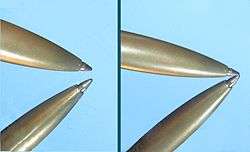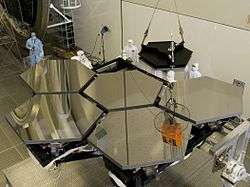First surface mirror
A first surface mirror or front surface mirror (also commonly abbreviated FS mirror or FSM) is a mirror with the reflective surface being above a backing, as opposed to the conventional, second surface mirror with the reflective surface behind a transparent substrate such as glass or acrylic. In cases where the mirror is subjected to extreme cold (as low as 33 K as in the James Webb Space Telescope), a polished pure beryllium mirror is used without a first surface coating in order to obviate buckling caused by differing coefficients of thermal expansion.


They are made for applications requiring a strict reflection without a ghosting effect as seen with a second surface mirror, where a faint secondary reflection could be observed, coming from the front surface of the glass. This includes most optics applications where light is being manipulated in a specific manner. Telescopes, rear-projection televisions, periscopes, non-reversing mirrors, high quality kaleidoscopes, and the animation process Spectrafocus use this type of mirror.
Silvering
The "silvering" on a front surface mirror is usually aluminium for visible light and gold for infrared radiation.